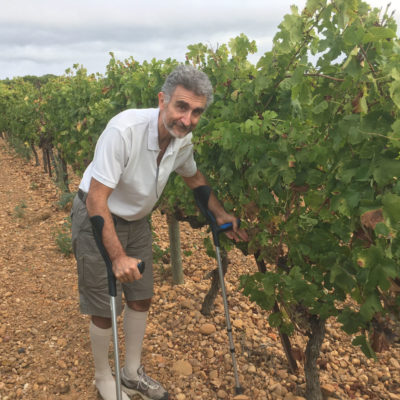At the cusp of autumn, I will try, as usual, to give you my read on this 2018 vintage. The vinification isn’t yet complete, and even if it was a vintage that often left us puzzled, its current contours confirm its very seductive quality.
After a very “low yield” 2017 vintage, the budbreak started vigourously at the end of March. Nature was generous this year, with a significant amount of clusters and great conditions at flowering. This winemaker was grinning…
Then our region went through a hot and wet spell the months of April and May where it was raining almost every other day, creating humid conditions that downy mildew just loves. The parasitic pressure was the highest I have ever encountered in my career and the battle was fierce, especially since we farm organically our vineyards.
In response, we intensified preventive measures to create a less favorable environment for downy mildew. We began our vineyard work by hand with debudding, followed by careful leaf stripping to aerate the canopy close to the grapes, then cluster-thinning to allow the grapes to dry faster after the rain. Our team of drivers were also on the front, often intervening weekends or nights, whenever the weather allowed.
Then summer finally arrived — hot, dry and long. The virulence of the mildew faded, it was time to evaluate the damage… There was a bit of loss to the foliage, especially on Grenache, but the fruit was almost totally intact and healthy, despite some losses in our youngest vineyards. We came out in good shape!
Then another misfortune – but for the winemaker this time! Fifteen days before the harvest, I took advantage of little free time to do a bike run in the Cevennes. It ended short with a femoral neck fracture. Operation, wheelchair, crutches, my role in the 2018 harvest had to be redefined. The team was incredible, pitching in generously and the grape harvest took place with much serenity. I ended up being more of an “internal adviser”, tasting a lot, doing maturity checks in the vineyards (on crutches, of course), but doing nothing operational. My first harvest without wine-stained hands – talk about frustration!

Thanks to exceptionally favorable weather, each plot could be picked at optimum maturity. However, evaluating ideal ripeness became somewhat of a puzzle sometimes. The summer’s heat gave us wonderful levels of grape ripening, but the warmer-than-usual nights produced less potential color and less acidity than the two previous vintages. By mid-August we had grapes showing low acidity (which is a sign of physiological maturity), while the aromatics and tannins remained vegetal. Adding to the “to pick or not to pick” conundrum was the fact that the usual order of ripeness across plots and even across varietals didn’t resemble anything we had previously experienced. We chose to ignore the lab analytics and we stuck to tasting the berries in order to make our harvest decisions.
In the winery, most of our fermentations took place with indigenous yeasts and in absence of any SO2 additions, which we feel best respects the expression of each terroir. For the reds, we used some whole-cluster ferments for our oldest vineyards. Whites and rosés are very aromatic with a beautiful freshness of fruit and an ample mouthfeel, smooth and vivacious. The reds are bursting with fruit, have moderately deep color and extremely silky tannins.
My hunch today is that the wines of the 2018 vintage will be accessible early in a very seductive style.
To enter our website, you must be of legal drinking age in your country.